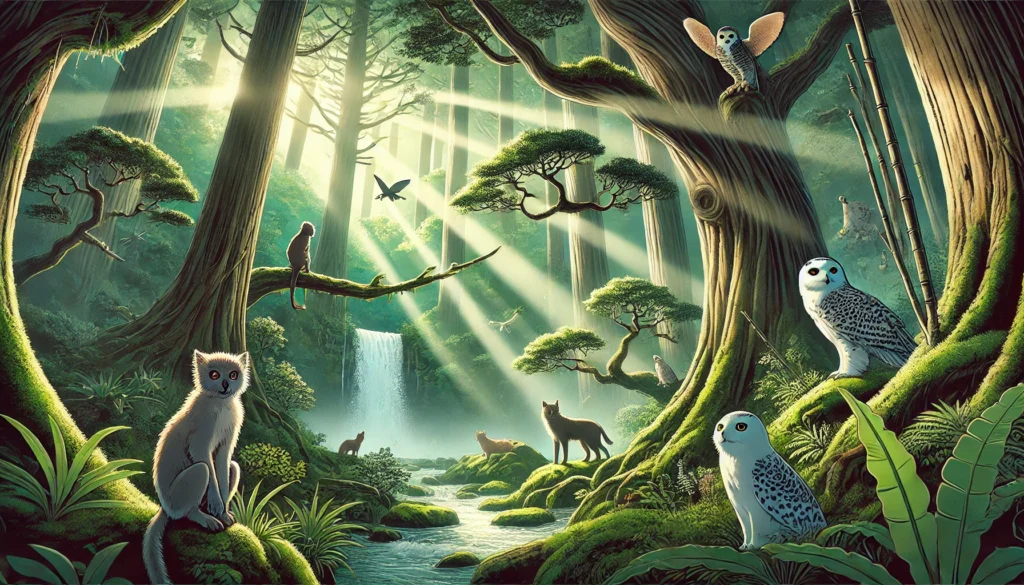Japan is home to an extraordinary variety of flora and fauna, making it one of the most biologically diverse regions in the world. Stretching from the subarctic waters of Hokkaido to the subtropical islands of Okinawa, the country’s unique geography, climate variations, and marine ecosystems contribute to its unparalleled richness in biodiversity.
In this guide, we will explore the fascinating aspects of Japanese biodiversity, from the country’s diverse marine life to its lush forests and rare endemic species. Whether you are a nature enthusiast, a traveler, or a researcher, understanding Japan’s ecological wealth is key to appreciating its natural wonders.
Why Japan is a Global Biodiversity Hotspot
Japan’s biodiversity is shaped by several key factors:
- Geographical Position: Japan is an island nation situated along the Eurasian coastline, covering a vast range of latitudes.
- Climate Diversity: The country experiences significant seasonal changes, from snowy winters in the north to tropical summers in the south.
- Ocean Currents: Warm and cold water currents, including the powerful Kuroshio-Oyashio system, contribute to diverse marine ecosystems.
- Mountainous Terrain: Over 70% of Japan is covered by mountains, fostering rich forest habitats.
- Marine Ecosystem: Japan’s coastline stretches over 30,000 km, offering access to deep and shallow water environments.
These factors make Japan one of the most ecologically diverse countries, supporting a vast range of species, some of which are found nowhere else in the world.
Japan’s Diverse Ecosystems
1. Marine Biodiversity: A Wealth of Ocean Life
Japan’s oceans host an incredible variety of marine life, from coral reefs in Okinawa to deep-sea creatures in the Pacific trenches. The convergence of warm and cold ocean currents creates a dynamic marine environment.
Key Marine Life in Japan:
- Japanese Spider Crab (タカアシガニ, Takaashigani) – The world’s largest crab, found in deep waters.
- Japanese Mola Mola (マンボウ, Manbō) – The giant ocean sunfish, often spotted off the coast.
- Japanese Pufferfish (フグ, Fugu) – A delicacy in Japanese cuisine, known for its toxic properties.
- Humpback Whales (ザトウクジラ, Zatō kujira) – Frequently seen in Japanese waters during their migration season.
- Coral Reefs of Okinawa – Among the northernmost coral reef systems in the world.
2. Forest Ecosystems: A Haven for Rare Wildlife
Japan’s forests, covering about 68% of the land, are home to ancient trees, unique wildlife, and rare bird species.
Notable Forest Regions:
- Yakushima Island – A UNESCO World Heritage Site known for its ancient cedar trees.
- Shirakami-Sanchi – A protected beech forest rich in biodiversity.
- Nagano & Gunma Forests – Home to Japanese macaques, also known as snow monkeys.
Rare Forest Species:
- Japanese Black Bear (ツキノワグマ, Tsukinowaguma) – Found in Honshu’s dense forests.
- Japanese Macaque (ニホンザル, Nihonzaru) – The famous hot-spring-bathing snow monkeys.
- Blakiston’s Fish Owl (シマフクロウ, Shimafukurō) – One of the world’s largest owls, native to Hokkaido.
3. Wetlands and Freshwater Habitats
Japan’s numerous rivers, lakes, and marshes provide essential habitats for fish, amphibians, and migratory birds.
Famous Wetland Areas:
- Kushiro Shitsugen (Hokkaido) – Japan’s largest wetland, home to the rare Japanese Red-Crowned Crane (タンチョウ, Tanchō).
- Lake Biwa – The country’s largest freshwater lake, supporting many endemic fish species.
- Izumi Crane Reserve (Kagoshima) – A winter home for thousands of cranes.
The Role of Ocean Currents in Biodiversity
One of the most defining elements of Japanese biodiversity is its marine current system, particularly the Kuroshio and Oyashio Currents.
Kuroshio Current (黒潮) – The Warm Water Flow
- Originates from the Western Pacific near the Philippines.
- Brings warm tropical waters northward along Japan’s eastern coast.
- Sustains coral reefs, fish populations, and marine mammals.
Oyashio Current (親潮) – The Cold Water Flow
- Comes from the Arctic regions and flows southward along Hokkaido.
- Carries cold, nutrient-rich waters, supporting krill, sardines, and whales.
- Encourages plankton blooms, which form the base of Japan’s marine food web.
The intersection of these currents creates one of the world’s most productive fishing grounds, attracting marine life from both tropical and polar regions.
Endangered Species in Japan
While Japan is rich in biodiversity, many species face threats from habitat loss, climate change, and human activities.
Critically Endangered Animals:
- Iriomote Cat (イリオモテヤマネコ, Iriomoteyamaneko) – Found only on Iriomote Island.
- Japanese River Otter (ニホンカワウソ, Nihonkawauso) – Declared extinct in 2012, though unconfirmed sightings persist.
- Amami Rabbit (アマミノクロウサギ, Amaminokurousagi) – A primitive rabbit species unique to Amami and Tokunoshima Islands.
- Okinawa Rail (ヤンバルクイナ, Yanbarukuina) – A flightless bird restricted to northern Okinawa.
Efforts in Conservation:
Japan has taken steps to protect its wildlife and natural ecosystems:
- Establishing national parks and protected reserves.
- Implementing endangered species protection programs.
- Promoting sustainable fishing and forestry practices.
Despite these efforts, continued conservation work is essential to preserve Japan’s biodiversity for future generations.
Japan’s Coral Reefs: A Unique Marine Treasure
Japan is home to some of the world’s northernmost coral reefs, located in Okinawa, Kagoshima, and the Izu Islands.
Threats to Japan’s Coral Reefs:
- Climate Change: Rising ocean temperatures have caused coral bleaching events.
- Pollution: Runoff from agriculture and coastal development damages reef ecosystems.
- Overfishing: Disrupts the balance of reef life, affecting fish populations.
Conservation Efforts for Coral Reefs:
- Marine protected areas to prevent overfishing.
- Artificial reef projects to support coral regeneration.
- Educational campaigns to raise awareness about reef conservation.
Conclusion: The Future of Japanese Biodiversity
Japan’s incredible biodiversity is a testament to its unique geography, ocean currents, and varied climate zones. From the icy waters of Hokkaido to the coral reefs of Okinawa, the country is a haven for wildlife, marine species, and rare ecosystems.
However, as climate change, deforestation, and pollution threaten Japan’s biodiversity, it is crucial to support conservation efforts, protect natural habitats, and promote sustainable living. Whether you are a traveler, researcher, or nature lover, appreciating and protecting Japan’s rich biodiversity ensures its survival for future generations.
Discover More About Japan & Japanese Culture 🇯🇵✨
Looking for more insights into Japanese life, language, and travel? Check out these must-read articles from Wakoku:
📖 Japanese Language & Learning Resources
🔹 Mastering Japanese Alphabet Pronunciation – Learn how to pronounce Japanese characters correctly.
🔹 A Beginner’s Guide to Writing Hiragana Characters – Start writing hiragana with confidence.
🔹 Learn Japanese Kanji Basics: A Beginner’s Guide – Master the foundations of kanji efficiently.
🔹 How to Type Japanese Letters Easily – Learn to type Japanese on your keyboard like a pro.
🔹 How to Say “Hello” in Japanese: The Ultimate Guide to Japanese Greetings – Learn essential Japanese greetings and when to use them.
🏯 Japanese Culture & Traditions
🔹 Experiencing a Traditional Japanese Bathhouse – Discover the etiquette and relaxation of Japanese sento and onsen.
🔹 Essential Drinks Vocabulary in Japanese: Order Like a Pro – Learn how to order your favorite drinks in Japan.
🔹 Mastering Nature Vocabulary in Japanese: A Comprehensive Guide – Expand your Japanese vocabulary with nature-related words.
🚀 Travel & Living in Japan
🔹 The Pros and Cons of Living in Japan: What You Need to Know Before Moving – Understand the ups and downs of living in Japan.
🔹 Kyoto Illumination 2024-2025: A Magical Winter Light Experience – Explore Kyoto’s stunning winter light displays.
🔹 Spas to Visit in Osaka: A Guide to Relaxation in Osaka – Find the best spas for unwinding in Osaka.
🗻 Adventure & Exploration
🔹 Japanese Seafood Names: A Comprehensive Guide for Seafood Lovers – Learn the names of seafood in Japanese for dining and shopping.
🔹 Expand Your Japanese Fruits Vocabulary – Discover common and unique Japanese fruit names.




